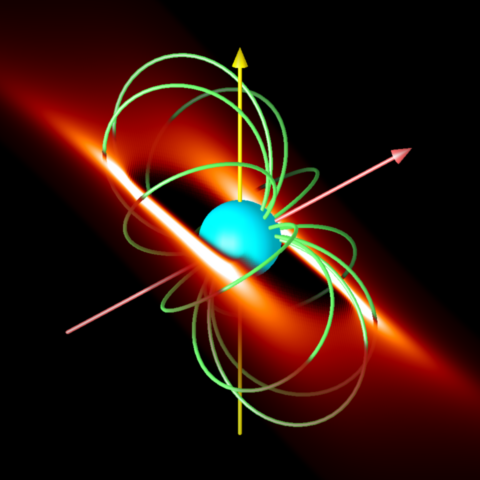Rigidly Rotating Magnetosphere movies
I've spent quite a bit of time working on nice visualizations for my Rigidly Rotating Magnetosphere model — in part, because it's a fun computer graphics challenge, but also because this sort of thing always helps when it comes time to write funding proposals.

A single frame from one of the RRM movies, shown using the redtemp color scheme.
This page hosts grids of RRM movies, spanning a range of rotation rates ω/ωc, observer inclinations i and magnetic obliquities β. Each movie shows the star and surrounding magneotspheric matter distribution, viewed over a complete rotation cycle comprising 256 frames. To provide visual clues to the 3-D geometry, the rotation and magnetic axes are shown (in yellow and red, respectively), as are selected field lines (green) for the assumed dipole magnetic topology.
Each movie is available in three variants. The redtemp variants use IDL's 'Red Temperature' color table to show the magnetospheric matter distribution, with brightness coding for relative optical depth. The doppler variants also uses brightness to code for optical depth, but the underlying color is determined from the line-of-sight velocity of the material (blue indicating motion towards the observer, and red motion away); because the material is in rigid rotation, this velocity is constant along each sightline. Finally, the observables variants additionally show the star's light curve, Hα emission and mean longitudinal field strength.
The redtemp and doppler movies have dimensions 480 x 480, while the observables ones are slightly larger at 512 x 512 (due to margins between each panel). All are encoded using FFmpeg, with an MPEG-4 Part 2 codec (fourcc FMP4) inside either an AVI container (extension .avi) or an MPEG-4 container (extension .mov). To play the AVI movies, you'll probably have to install some software — ffdshow for Windows, Perian for Mac, and mplayer for Linux. The MPEG-4 movies should work with Apple's Quicktime player. More information on movie formats can be found here.
Update (2009/09/26) The doppler and observables variants were missing in the MPEG-4 (MOV) format; this has been fixed. Also, movies are now available for near-critical stars, rotating at ω/ωc = 0.99.
Download Individual Movies
To download an individual movie, choose the desired rotation rate, inclination, obliquity, variant and format, and then hit the Submit button. (Note that the default values are based loosely on the parameters of σ Ori E).
Each file is a little over 3 MB in size. Filenames follow the convention rrm-oOO-iII-bBB-VVV.FFF, where OO is 100*ω/ωc, II is the observer inclination in degrees, BB is the magnetic obliquity in degrees, VVV is the variant (one of redt, dopp or obs), and FFF is the format (one of avi or mov).
Download Bundles
To simplify the downloading of large numbers of movies, I've bundled the AVI ones up into the following tar archives:
- redtemp variant:
- ω/ωc = 0.25 (179 MB)
- ω/ωc = 0.50 (171 MB)
- ω/ωc = 0.75 (172 MB)
- ω/ωc = 0.99 (169 MB)
- doppler variant:
- ω/ωc = 0.25 (174 MB)
- ω/ωc = 0.50 (167 MB)
- ω/ωc = 0.75 (170 MB)
- ω/ωc = 0.99 (168 MB)
- observables variant:
- ω/ωc = 0.25 (164 MB)
- ω/ωc = 0.50 (160 MB)
- ω/ωc = 0.75 (162 MB)
- ω/ωc = 0.99 (162 MB)
Note that these files are quite large, and may take a while to download.
Production Methodology
To produce these movies, I use the following steps:
- A large (512 x 512 x 512) datacube of density values is generated for the appropriate ω/ωc and β, using the RRM formalism described by Townsend & Owocki 2005
- For a given i, an IDL script creates a set of framebuffer files, one for each of the 256 frames of the movie. A framebuffer stores an image of the 'furniture' elements (star, axes, field lines) of a scene, plus the z values of the pixels (see here for a discussion of z-buffering).
- Optical depth information is added to the framebuffers. For each framebuffer pixel, the optical depth is integrated through the datacube from the observer to the appropriate location determined from the z-buffer.
- Alpha compositing is used to combine the color and optical depth information in each framebuffer; the resulting images are written out as PNG files.
- Finally, FFmpeg is used to encode the PNG files into an AVI/FMP4 or MPEG-4 movie.
The whole process is quite time-consuming; on a single processor core, a complete movie can take upwards of a day. (This is in part because to implement anti-aliasing I construct the framebuffers with a high resolution, and subsequently down-sample to the final 480 x 480 resolution.)
